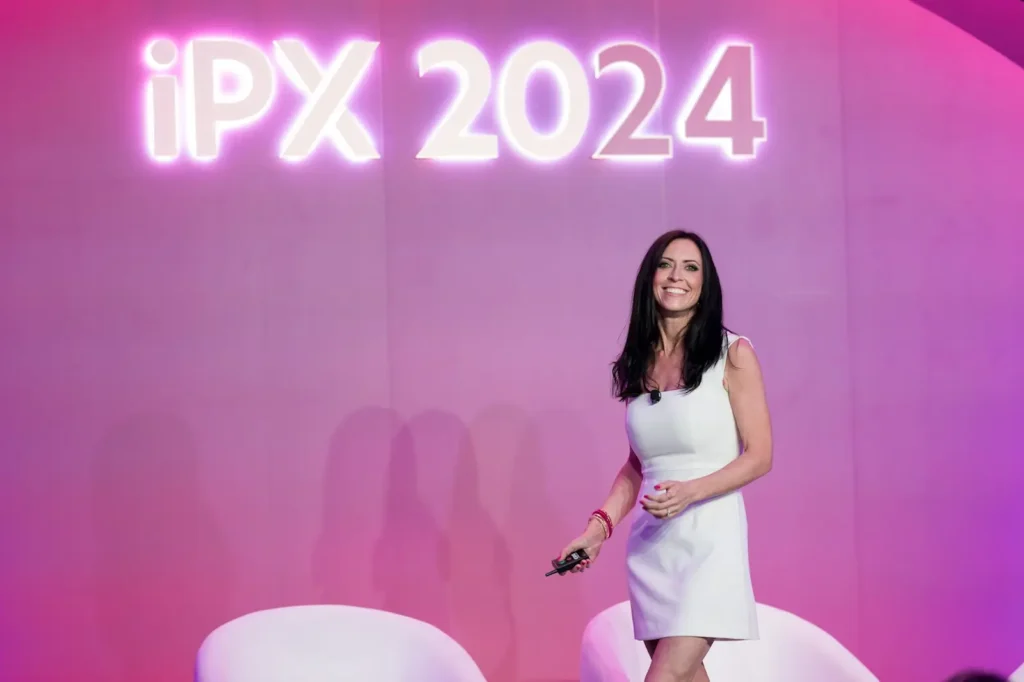At Partnerships Experience 2024 (iPX), renowned brands and publishers gathered in the heart of New York City to discuss one shared interest: the power of partnerships.
With the glittering Hudson River as their backdrop, the partnership economy’s major players gathered to network and exchange innovative ideas for business growth. The event featured two days of keynotes, breakout sessions, and panel discussions that explored new ways to think about marketing.
Find out what iPX attendees learned at the event and discover key insights from each panel.
Jump to a specific panel recap:
- Opening keynote: From full funnel to full circle
- Best-in-class practices for best-in-class programs
- Unlocking the potential: Adapting to digital industry shifts
- Collaborate to elevate: Breaking down silos
- You’ve got a friend in me: Customer referral channel
- Balancing act: Wellness in the workplace
- The power of generative AI for scaling partnerships

Opening keynote: From full funnel to full circle
In recent years, the customer journey has become a more all-encompassing experience. Partnerships—such as affiliates, creators, and other businesses—play a crucial role in shaping consumer behavior, building community, and boosting sales. Our expert panel delved into the nuances of this new model and discussed how brands can handle its measurement and attribution challenges.
The panelists included:
- Kayla Castro, Senior Manager of Affiliates and Partnerships at Zenni Optical
- Michelle Pushefski, Senior Lead of Growth Partnerships at Shopify
- David A. Yovanno, CEO of impact.com

1. Adjust to the modern marketing funnel
The shift from a linear marketing funnel to a dynamic, circular customer journey model has transformed the way brands approach marketing. The traditional funnel’s confined linear steps have evolved to include new stages: discovery, research, engagement, conversion, retention, and advocacy.
This new model views the customer journey as an ongoing cycle, where customer advocacy is crucial in influencing potential buyers. Today, brands must shift focus to building symbiotic partnerships consistently throughout the customer journey.
2. Harness the power of community
Millennials and Gen Z pay attention to brands that create a sense of community and belonging. Cultivating this sentiment in customers enhances your brand, fostering authentic advocacy that moves beyond transactional ties. Building genuine relationships can lead to organic growth, as satisfied customers are more likely to share positive experiences and engage in word-of-mouth promotion.
More authentic content types, such as user-generated content (UGC), can also serve as a powerful bridge between partnerships and advertising. UGC significantly boosts conversion rates and maintains customer engagement post-purchase.
3. Adopt an incrementality mindset
Numerous touchpoints and varying partner roles make measuring partnership program efficacy more challenging. Adopting a multi-touch attribution approach and using sophisticated tools can help you assess how various partners affect the customer journey.
Practical strategies include incrementality testing, data sharing with partners, and educating internal stakeholders. These measures are crucial for solving measurement problems and showing partnership program ROI.

Best-in-class practices for best-in-class programs
While the affiliate channel has been a cornerstone of digital marketing for years, it continues to offer new opportunities for large-scale enterprise brands. The panel included successful brands using affiliates to explore implementing innovative strategies to scale, optimize partner relationships, and achieve outstanding results.
The panelists included:
- Elisa Charbonnel, Director of Global Paid Media and Performance Partnerships at Disney Streaming
- Ga-Young Lee, Senior Manager of Digital Media, Content Affiliate Marketing, and Partnership at Walmart
- Bennett Rosenblatt, Senior Performance Marketing Lead at Uber
- Faique Moqeet, Founder and CEO at Hamster Garage

1. Build strong partner relationships
The best-in-class affiliate programs prioritize partner relationships by concentrating on high-potential partners. They approach partnerships collaboratively, align their goals, and share challenges. Engaging partners in data analysis and decision-making strengthens the relationship and leads to greater success.
Routine surveying is one actionable way for brands to engage partners regularly. These surveys give partners a voice and provide valuable feedback to the brand, leading to greater program effectiveness and overall partnership success.
2. Measure incrementality and testing
Measuring partnership incrementality is challenging but necessary for running a top-tier affiliate program. The most successful programs creatively quantify and test partners’ impact, looking beyond first-time orders and purchases. This strategy can lead to more strategic spending and greater profitability.
Using AI in incrementality measurement can provide deeper insight into partnership value. Even in the early stages of its integration, AI can help you discover innovative strategies and new publisher types. It could enhance partner targeting, audience engagement, and content personalization in the future.
Affiliate programs can also provide greater value to other parts of your organization. Consider using your program as a testing ground for new marketing strategies, helping identify the most successful approaches and innovate within your marketing mix.
3. Sell the vision and value of affiliate marketing
To realize an affiliate program’s full potential, program leaders must excel at selling their program’s vision and value within their organization. This will help you gain internal support and alignment, which is especially important for mature programs.
Employ storytelling to emphasize your program as a measurable, testing-focused channel. By adopting industry best practices and learning from other brands, you can showcase your program’s potential for growth and innovation. Focus on continuous learning, collaboration, and strategic positioning to gain stakeholder buy-in.

Unlocking the potential: Adapting to digital industry shifts and evolving consumer trends
From platform algorithm changes to economic headwinds, there’s no shortage of forces shaping today’s brand affiliate programs. To help businesses navigate these shifting dynamics, the panel discussed the different pressures facing brands today and approaches to keep them competitive.
The panelists included:
- Michelle Nadel, Associate Director of Digital Media at Walmart
- Joelle Hargadine, Senior Marketing Manager at Vista
- Jim Grace, Vice President of Business Development at Zeropark
- Emma Tett, VP of Agency Innovation at impact.com

1. Diversify your partner mix
Diversifying partnerships broadens audience reach and enhances program performance. Engaging with many partner types—such as influencers, content creators, and commerce platforms—allows businesses to tap into various revenue streams and cater to a wider customer base.
However, selecting the right partners and providing incentives tailored to their varied interests can present a challenge. Analyzing accessible data allows brands to make more informed decisions about their mix and adjust it for optimal results. Using different commission models based on partner categories and pay-out groups to effectively align with publishers.
2. Stay agile with contingency planning
Adaptability and contingency planning are essential in response to industry shifts. To navigate these uncertainties, brands must be agile and “expect the unexpected.”
Put contingency plans in place to respond swiftly and effectively to algorithm adjustments, AI disruptions, emerging consumer trends, and other changes. This proactive mindset will give you an edge over competitors when unforeseen events arise.
3. Embrace an omnichannel approach
Sticking to traditional platforms can limit your potential growth and prevent you from tapping into new opportunities. Instead, take an omnichannel approach to reach consumers wherever they make purchases. This strategy enables brands to stay afloat amidst industry changes and effectively follow consumer trends.
To accomplish this, brands can use mixed media models, micro-reviews, and Google Analytics to better understand their campaign impacts. They can also explore the potential of emerging commerce platforms such as TikTok and YouTube.

Collaborate to elevate: Breaking down internal silos and fostering holistic partnerships success
Overcoming departmental barriers and encouraging collaboration among teams working toward a common goal can take a brand’s affiliate program to new heights. The panel explored effective ways of empowering teams to break traditional boundaries, collaborate effortlessly, and gain stakeholder support.
The panelists included:
- Jennifer Kim, Director of DTC Acquisition and Marketing at Helen of Troy
- Sam Kimmel, Senior Director of Marketing Partnerships at Hello Sunshine
- Carolann Mckay, Director of Social Commerce at Walmart
- Todd Crawford, VP of Strategic Initiatives at impact.com

1. Cultivate curiosity and collaboration
Foster a culture of collaboration across teams to see greater program success. Expressing interest in the work of other stakeholders can help achieve a more holistic understanding of business goals. Additionally, a curious mindset encourages better inter-team communication and alignment.
Holding regular cross-departmental meetings allows team members to share insights and updates, encouraging them to ask questions and explore different areas of the business. Also, consider setting up collaborative projects requiring multiple departments’ input to foster a sense of shared purpose.
2. Emphasize data-driven decision-making
Use data to make decisions, monitor performance, and showcase the value of partnerships. This approach aligns strategies with business goals and shows program ROI, improving your chances of gaining stakeholder support and strengthening your case for initiatives.
Prioritize gathering quantitative data and qualitative feedback to create a comprehensive picture of success. Analytics tools and automated reporting systems can help streamline KPI tracking and provide real-time insights. Also consider performing regular data audits to ensure data integrity and accuracy.
3. Focus on communication and self-advocacy
Clear and consistent communication with all stakeholders—team members, supervisors, and external partners—enhances cross-team alignment. You can garner greater support by clearly outlining the goals, objectives, and results of your affiliate initiatives. Regular updates and transparent reporting show the value of your work and how it affects others within the organization.
Advocating for the value of your affiliate partnerships can secure the recognition, resources, and backing your program needs to thrive. Highlight affiliate programs during key meetings and strategic planning sessions to keep them a priority.

The convergence of affiliate and creator: A winning partnership
With consumers increasingly favoring trusted recommendations over ads, brands seek new ways to use affiliate and creator marketing. This panel explores the powerful synergy between these channels, offering success stories and actionable strategies to tap into the new customer journey.
The panelists included:
- Amelia Glynn, VP of Influencer at Acceleration Partners
- Vana Han, Global Partnerships Lead for SMB at TikTok for Business
- Brittny Kindred, Senior Manager of Media Partnerships at The Home Depot
- Jessica Turner, Creator at The Mom Creative
- Caitlyn Kumi, Creator at Miss EmpoweHer
- Olivia Savage, Senior Marketing Strategist of Creator Growth and Engagement at impact.com

1. Maximize creator partnerships with bonus structures
Bonus structures provide powerful incentives for creators to achieve better results and promote a brand more frequently.
Brands should consider incorporating such bonus structures into their affiliate programs to attract and retain high-performing creators. These structures provide creators with tangible compensation they find appealing, leading to higher engagement and better performance.
2. Look at a wide range of performance metrics
Brands should look beyond traditional metrics such as sales and conversions. Tracking alternative indicators—such as shares, comments, and saves—is crucial to effectively gauge a creator program’s success. These metrics offer a deeper understanding of audience engagement, brand affinity, and conversion potential.
Use analytics tools to track real-time metrics, allowing you to adjust your strategies quickly. Setting clear benchmarks for engagement and periodically reviewing performance also ensures that creator efforts align with overall brand objectives.
3. Strategically nurture your influencer relationships
When selecting partners, brands should consider the creators’ level of community engagement, personal brand influence, and conversion potential. Finding creators with robust communities and diverse audience segments can expand reach and effectiveness exponentially.
Brands should also prioritize continuous learning, staying attuned to evolving trends and audience preferences. Conduct regular creator performance reviews to uncover new opportunities for optimization and ensure that campaigns remain impactful.
Ultimately, this dynamic approach fosters stronger, more productive relationships that drive sustained growth and engagement.
You’ve got a friend in me: Reach and acquire new audiences through the customer referral channel
Referral marketing can turn customers into growth partners and increase engagement. In this session, the panel shared practical strategies for building a referral program that creates genuine connections, drives sustainable growth, and fosters loyal advocates.
The panelists included:
- Aneira Henery-Morley, Global Head of Partnerships at capital.com
- Meaghan Sullivan, Global Marketing Customer Programs Lead of Google Workspace Marketing at Google
- Keith Posehn, CEO at Zorz
- Will Fraser, General Manager and Co-Founder of SaaSquatch at impact.com

1. Design your program around authenticity
Successful referral marketing programs hinge on forging authentic connections. Genuine customer stories and referrals often deliver a stronger return on ad spend (ROAS) and higher conversion rates than other marketing techniques.
Use existing customer feedback to refine your messaging and align referral incentives with your brand values. Avoid over-incentivizing customers, as this can compromise authenticity. Instead, foster trust by finding the right balance with incentives to ensure your referrals are value-driven—not just transactional.
2. Collaborate with product teams
A strong alliance between the marketing and product teams is essential for effective referral programs. This collaboration allows marketers to portray genuine stories and create a seamless customer experience. In turn, products can use customer feedback to enhance product offerings—creating a win-win relationship.
Set up regular touchpoints to share insights and refine the referral strategy based on real-time customer feedback. You can also use analytics to track referral performance and uncover areas for improvement.
3. Use robust tools for scalability and efficiency
Your referral program must remain reliable and consistent to prevent disruptions and ensure a seamless customer experience. Robust tools designed to manage the referral channel—such as impact.com / advocate—enable brands to enhance program scalability and efficiency.
Additionally, tools that foster cross-functional team collaboration, encourage self-service, and provide valuable analytics are recommended for making data-driven decisions and achieving overall program success.

Balancing act: Wellness in the workplace
Prioritizing innovation often compromises mental wellbeing in the affiliate industry and beyond, but it doesn’t have to be this way. During this session, the panel offered practical strategies for achieving a healthy work-life balance, managing stress, and fostering a supportive workplace culture.
The panelists included:
- Jun Yoshida, Senior Wellness Program Manager at LinkedIn
- Locke Hughes, Head of Health Content at ŌURA Ring
- Alyson Watson, CEO at Modern Health
- Michelle Denman, Chief People Officer at impact.com

1. Recognize the critical connection between mind and body
Achieving work-life balance relies heavily on both mental and physical health. Treating these aspects as interconnected and advocating for an integrated approach to wellness is crucial. Experiment with different fitness routines, diet plans, and mindfulness techniques to discover what works best.
Brands with affiliate programs should prioritize the holistic wellbeing of their partners to encourage the best performance possible. By promoting this integrated approach, brands can create healthier work environments, boost productivity, and create better relationships.
2. Share accountability for workplace wellness
Maintaining wellness in the workplace is a dual responsibility that requires both employers and employees to be proactive. Brands should actively engage their employees to develop wellness initiatives that benefit everyone involved. By designing programs using this feedback, these initiatives can be practical and beneficial.
Employees should also take responsibility for their health by utilizing available resources and practicing self-care. A healthy and happy workforce leads to a more productive and successful business.
3. Disconnect and get enough rest
Rest and stress management are crucial for overall wellness. In Western work cultures, there’s often a stigma around taking breaks, but disconnecting from work and technology can significantly reduce stress.
Morning sunlight exposure, controlled breathing exercises, and regular outdoor activities are all effective stress management techniques. Building strong social connections at work is also important. Brands should promote these practices to foster a balanced work-life culture.
The power of generative AI for scaling partnerships
As we know it, AI has rapidly revolutionized partnerships, enhancing efficiency and making campaigns more impactful than ever. In this panel, industry experts discussed how AI-driven tools can streamline content creation, boost brand messaging, and transform the customer experience.
The panelists included:
- Peter Orlowsky, Senior Vice President of Strategic Development at Getty Images
- Suruchi Shukla, Vice President of Marketing at Minted
- Sam Liu, Senior Manager, Customer Success at 6sense
- Jerrid Grimm, Head of Publisher Marketing at impact.com

1. Consider the many ways AI can enhance your business
Generative AI plays a pivotal role in enhancing partnership programs. For brands, it can simplify tasks such as content creation, email writing, and personalizing briefs for partners. This leads to improved productivity, creativity and more engaging collaborations.
AI can also bring a brand’s creative vision to life in new ways by allowing teams to create unique scenarios that are difficult to achieve with traditional photography.
Exploring Gen AI’s capabilities could be transformative for optimizing their affiliate programs. Gen AI can analyze vast amounts of data for more precise targeting and segmentation, enabling brands to create dynamic content that adapts in real time based on audience engagement. By incorporating these strategies, marketers can achieve unprecedented precision and flexibility, making their campaigns more compelling.
2. Strategically balance AI and human touch
While AI enhances efficiency and scalability, human-generated content’s unique artistry and perspective remain invaluable. Brands must navigate how to fairly compensate for both types of content, ensuring AI complements rather than replaces human creativity.
Continuous experimentation is essential to achieving this balance. Regularly assess the effectiveness of human and AI-generated content using analytical tools and audience feedback. This approach will help refine strategies, ensuring both elements work together to elevate partnership programs.
3. Build transparency and trust with AI tools
Though AI has great potential, brands should use it strategically and responsibly. Everyone needs a clear understanding of how these AI tools are created and function to ensure its outputs are reliable, accurate, and aligned with brand guidelines.
Establishing transparency and trust in AI technologies is crucial for adoption and seamlessly integrating Gen AI into partnership strategies. Conduct regular audits of AI outputs and provide thorough training for team members to ensure they’re well-versed in responsible AI use. Additionally, encourage an open dialogue with partners about AI to further cement trust and ensure alignment.

Make your partnership programs realize their full potential
Each iPX session delivered valuable insights on optimizing partnership program effectiveness, fostering strong partner relationships, and adapting to evolving consumer behaviors.
By applying these strategies, participants in the partnership economy can develop more impactful programs and marketing efforts. Integrate these best practices into your daily operations and watch your partnerships flourish.






